Abstract: A point-to-point real-time mobile video surveillance system is designed. The system is based on the embedded hardware platform, with TI's TMS320DM365 multimedia processor as the core processor, using embedded Linux technology, through the telecom CDMA2000-VPDN (Virtual Private Dia-Network) for video data transmission. Because VPDN has the characteristics of high reliability and strong confidentiality, the system has high application value in the occasions of high confidentiality requirements such as home indoor and vehicle monitoring.
Keywords: TMS320DM365; 3G-VPDN; video surveillance; embedded Linux
Introduction With the gradual promotion of 3G technology in China, the application of 3G technology in the video surveillance industry has become a hot spot. As one of the three mainstream 3G technology standards, CDMA2000 has developed rapidly in China. China Telecom's CDMA2000 system is mainly used in CDMA2000 1x for voice and low-speed data and CDMA20001xEV-DO (Evolution-Data Only) for video and high-rate data. CDMA20001xEV-DO theoretically supports downlink data rates up to 3.1 Mbps and uplink rates up to 1.8 Mbps in the case of high-speed data packets transmitted over a wireless channel. China Telecom's data service charges are calculated based on traffic or time. As China Telecom vigorously promotes 3G services, the costs are gradually reduced, providing favorable conditions for the popularization of CDMA2000 networks. 3G network video surveillance is also getting more and more attention. In this context, this paper proposes a video surveillance system based on CDMA2000-VPDN.
1 system features and features
1.1 Functional Description The system proposed in this paper has the following functions:
1 Support 3G wireless access of front-end equipment to achieve free wiring and improve installation speed.
2 privileged users can browse real-time images and control the pan/tilt and lens of the monitoring point.
3 Users can browse monitoring points in real time through the 3G mobile phone client.
4 platform alarms include motion detection alarms, infrared detection alarms, and can notify users by dialing.
5 Recording and picture resources are stored centrally in the front-end encoder, and the video stream is directly transmitted by the device to the user 3G mobile phone client.
1.2 System Features 1 The processor adopts TI's new TMS320DM365 digital media processor based on DaVinci technology. The TMS320DM365 is highly integrated with components such as the H264, MPEG4, and MPEG2 codecs, and an integrated image signal processing (ISP) solution for intelligent video processing. The integrated components greatly reduce development time and reduce development costs. This article uses the high-performance H264 encoder component of TMS320D-M365, which greatly reduces the video data and reduces the burden on 3G network data transmission.
2 using embedded Linux operating system. This system uses an open source embedded Linux operating system. Its good scalability and portability, excellent efficiency and stability, and support for multiple processor architectures make Linux more and more widely used in the embedded field.
3 Supported by the 3G-VPDN platform of Telecom CDMA2000. The system is based on the 3G-VPDN platform of CDMA2000. The 3G-VPDN (Virtual Private Network) adopts the security-dedicated tunnel technology to provide high security protection to the target network, preventing user privacy and information leakage. Moreover, the 3G mobile phone client can be accessed anytime and anywhere to realize real-time mobile monitoring.
4 system monitoring uses motion detection technology. The system uses motion detection technology, video motion detection combined with infrared detection, which greatly enhances the reliability of system alarms. With the intelligence of video surveillance, new technologies such as motion detection and pattern recognition have been introduced into video surveillance systems. Intelligentization is an inevitable trend in the future development of video surveillance.
2 realization principle and system structure
2.1 System Overall Framework The overall framework of the system is shown in Figure 1. The system includes a front-end embedded intelligent video monitor, a 3G-VPDN authentication platform, and a mobile phone monitoring client. The whole system is based on embedded intelligent video monitor, with telecom CDMA2000-VPDN as the network support, and 3G smart phone as the remote monitoring client.
This article refers to the address: http://
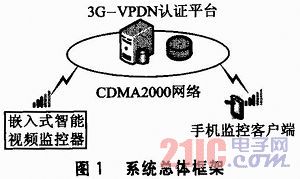
The embedded intelligent video monitor collects the video data of the scene, and uses the motion detection technology, combined with the infrared alarm module of the monitor, to determine whether someone is in the monitoring area. If it is detected that someone is in the monitoring area, immediately dial the system's preset 3G mobile phone number to send an alarm. After the 3G mobile phone receives the call, the user chooses to start the mobile video monitoring client to initiate the VPDN connection. After the 3G-VPDN authentication platform is authenticated, the embedded video monitor also establishes a VPDN connection, and establishes a video monitor and a mobile client endpoint point VPDN. connection. The UDP and TCP protocols are used to interact with the embedded intelligent controller, such as whether the user requests the embedded intelligent controller to send live video data to the mobile phone client, whether to request the PTZ control, and to cancel the alarm. At the same time, when the 3G mobile phone client is not alerted, it can also actively call the embedded video monitor to apply for establishing a VPDN connection for active access, and can authorize the local monitoring screen in real time.
2.2 Hardware structure of embedded intelligent monitor The hardware structure of the system is shown in Figure 2. The system main controller uses TI's DaVinci processor TMS320DM365. The main modules of the system include: CCD video signal acquisition camera, A/D conversion module, PTZ controller, infrared detection module, SD card storage module, EVDO 3G module. The wired network interface module in the figure is mainly used to debug system software.
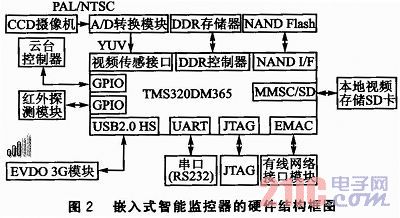
2.2.1 CCD Video A/D Conversion Module Circuit The A/D conversion chip uses TI's high-performance video decoding chip TVP5146 to complete the conversion from analog to digital video. TVP5146 not only supports A/D conversion of RGB and YPbPr signal components, but also supports A/D conversion and decodes NTSC, PAL, SECAM, and S-Video as YCbCr signal components. It allows 10 analog video inputs, with 4 10-bit A/D converters; field sync signal VS, line sync signal HS, odd-even field signal FID, clock output signal DAIACLK, etc. are all directly derived from the pin, eliminating the need for synchronous clock Circuit settings.
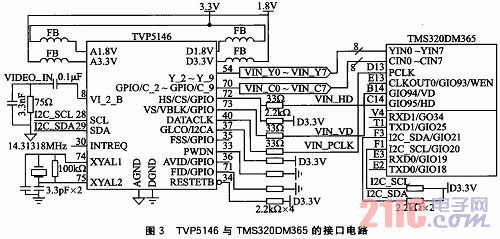
Figure 3 shows the interface circuit between TVP5146 and TMS320DM365. The PAL analog signal from the CCD output is connected to VIDEO_IN, and the second A/D converter of TVP5146 enters the pin VI_2_B to convert the digital video signal (4:2:2YCbCr), TVP5146. The output is a 10-bit digital video signal, and the TMS320DM365 supports 8-bit digital video signals. Therefore, the TVP5146 uses an 8-bit mode output, that is, the lowest 2 bits of the video Y component and C component are not connected, and the TVP5146 pins Y_2~Y_9 and GPIO /C_2~GPIO/C_9 are connected to pins YIN0 to YIN7 and CIN0 to CIN7 of TMS320DM365, respectively. The SCL and SDA pins of the TVP5146 are connected to the I2C_SCL and I2C_SDA pins of the I2C interface of the TMS320DM365, respectively. The TMS320DM365 configures the registers of the TVP5146 through the I2C bus.
2.2.2 3G-EVDO Internet Module Circuit This module is designed based on Huawei's MC703-CDMA-EVDO wireless module. The module supports CDMA 800/1900 frequency band and provides rich user signal interface: power interface, 1 channel 9-wire full serial port, 2 channel analog audio interface, 1 channel RUIM card interface, 1 channel USB2.0 full speed interface, up to 8 channels. GPIO interface, 2 DC interfaces. Support standard AT instruction set and Huawei extended AT instruction set. The interface circuit of the EVDO Internet module is shown in Figure 4.
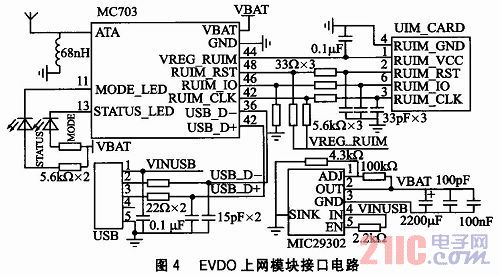
The EVDO internet module interface circuit includes a USB interface circuit of the MC703, an interface circuit of the UIM card, and a power interface circuit. The USB interface of the MC703 works with the driver to map the serial port and control it through the serial port AT command. The EVDO module completes tasks such as 3G data connection, SMS, and dialing. Since the module antenna interface is sensitive to ESD (Electro-Static Discharge), a 68 nH inductor is added to the antenna circuit design as ESD protection. The LDO (Low-Dropout) power supply voltage regulator circuit is used on the power interface circuit, and the high current LDO power supply chip MIC29302 is used. A 2 200μF electrolytic capacitor is added to the VBAT at the output of the MIC29302 power supply to ensure a voltage drop caused by the EVDO module's power rise at low signals.
The MC703 module RUIM card interface is sensitive to ESD and also requires the design of a protection circuit. Figure 5 shows the RUIM card interface ESD protection circuit. The TVS (Transient Voltage Diode) used in the figure uses the low capacitance TVS array chip MSMF05LCC. The chip can form 4 bidirectional TVS with a shutdown voltage of 5 V and an interpole capacitance down to 4.5 pF to meet ESD (Air-15 kV, Contact-8kV) protection requirements. Design the MSMF05LCC as close as possible to the RUIM deck.
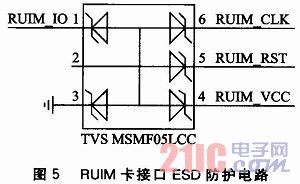
3 The software design of the system software design system is based on the embedded Linux platform. Before the system application software design, the embedded Linux development environment must be built first, the boot loader Boo-tloader is built, the Linux kernel is transplanted, the root file system is transplanted, and the script is written. , modify and porting Linux drivers and more. Then develop the application for the system.
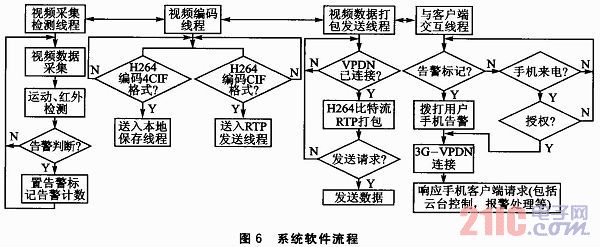
The system software flow is shown in Figure 6. The software design includes video capture detection, video encoding, packet transmission, and interaction with the client. The video capture detection thread includes collecting digital (4:2:2YCbCr) video signals accessed from the ISIF interface, determining whether someone is intrusive according to the video motion detection technology, combining the infrared alarm to determine whether an alarm is needed, and counting the alarms, so as to The alarm is counted. The video encoding thread calls the H264 encoding engine of TMS320DM365 to implement hardware encoding, and the encoding uses dual streams of 4CIF and CIF formats for local storage and 3G network transmission. The video data package sending thread packs the video data stream obtained by the encoding into the RTP (Real-time Transport Protoc01) protocol, and waits for the video connection request of the user, and establishes a VPDN-based UDP/TCP connection between the user mobile terminal and the intelligent monitoring terminal. When the user requests, the video stream data can be sent to the client in time. Interact with the client user thread to process alarms and receive incoming calls from users, as well as respond to customer's PTZ control requests. If the system displays an alarm message, dial the preset user's mobile phone instant alarm, then establish a 3G-VPDN connection, wait for the mobile phone client to connect to the 3G-VPDN, and interact with the mobile terminal on the VPDN network (including PTZ control, whether Clear alarms, etc.).
Conclusion In this paper, the hardware of the network video surveillance system based on CMDA2000-VPDN is modularized, and the hardware interface circuit of the main module CDMA2000 Internet module and video A/D conversion module is introduced. The software uses the design of embedded Linux and gives the main software flow. At present, the system is in the initial debugging, and the experiment has achieved good results. The functions of each module are basically realized, the video display is clear, the 3G network transmission is smooth, and the detection alarm reliability is high.
Traditional solar system includes so many parts: traditional lamp ( or LED lamp), Solar Panel, lead-acid battery, controller, solar panel brackets, battery cabinets. The volume is very large, therefore freight charge is very high, and labor cost of mounting is also very high. But Ruifeng`s Solar Smart integrated solar LED Street Lights solve all the above problems and troubles. Ruifeng has designed and developed a unique [SolarSmart"-all in one Integrated solar street lighting module, Fit and Forget built with intelligent Microcontroller charge controller system, comprising High Efficiency
12W Integrated Solar Street Lights
12W Integrated Solar Street Lights,12W Solar Street Lights,Solar Led Street Light,Solar Street Lamp
Yangzhou Bright Solar Solutions Co., Ltd. , https://www.solarlights.pl